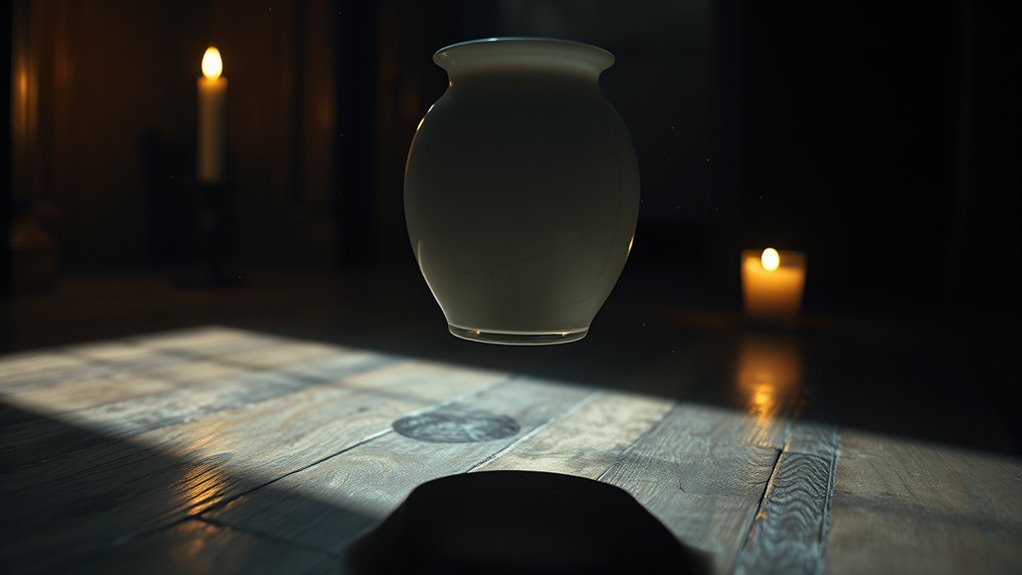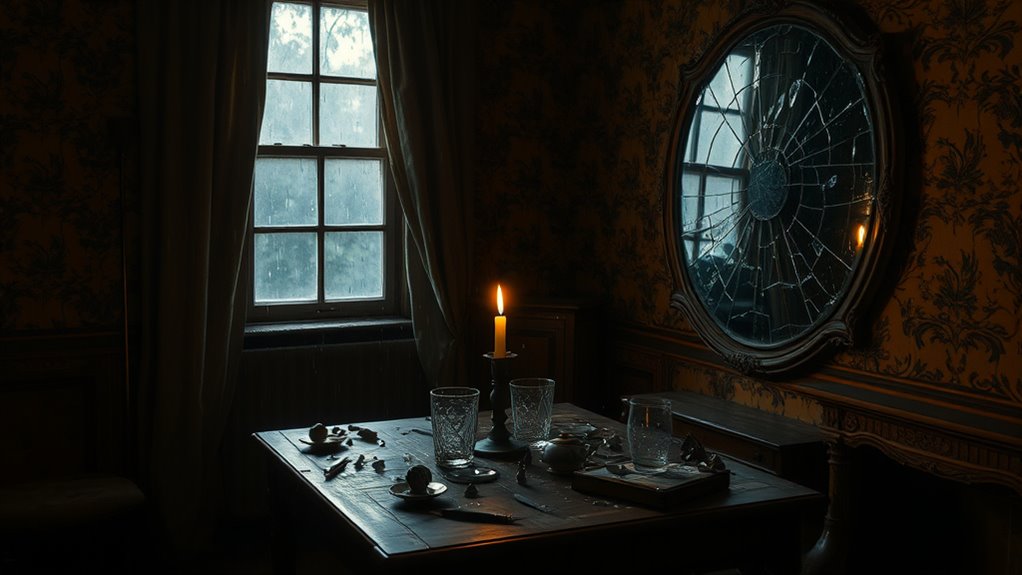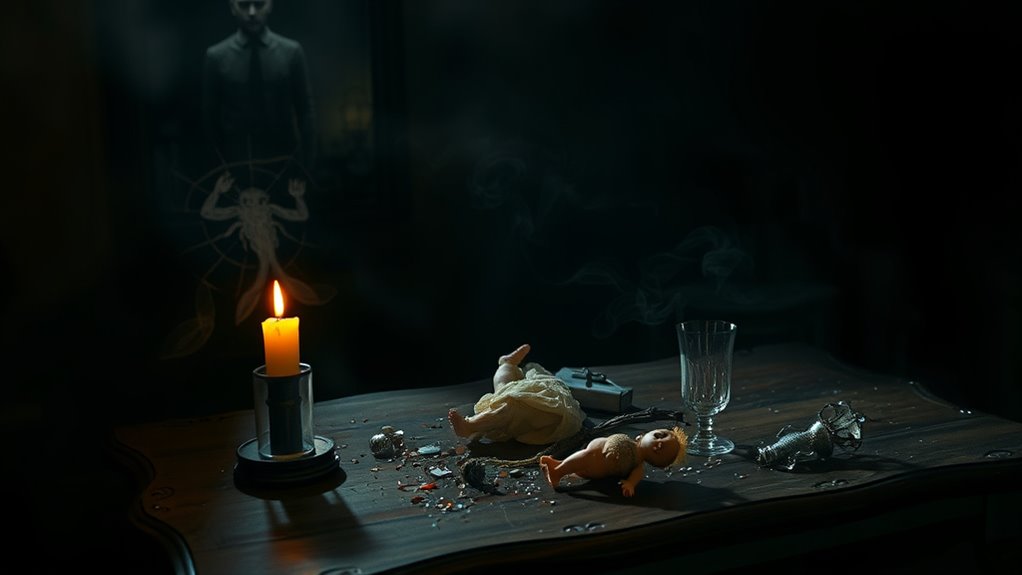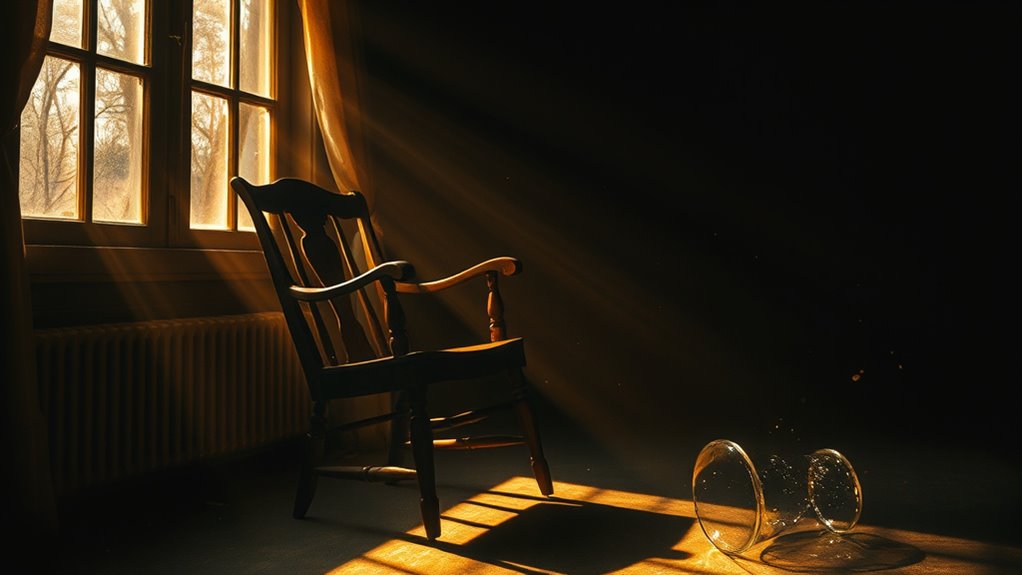Poltergeists are chaotic spirits that interact with the physical world, often throwing objects and creating disturbances like slamming doors. You might find them in energy-rich areas such as kitchens and bathrooms, where they carry out mischievous antics. About 25% of Americans believe they’ve experienced poltergeist phenomena, reporting strange disturbances. Understanding their behavior and the environments they thrive in can help you identify and engage with them effectively. There’s much more to discover about these fascinating entities.
Key Takeaways
- Poltergeists are invisible entities known for chaotic interactions, like throwing objects and creating disturbances in energy-rich areas.
- They are linked to Recurrent Spontaneous Psychokinesis (RSP), where human emotional energy influences object movement.
- Rapid item throwing every half second and distinct sound patterns indicate poltergeist presence.
- Personal experiences and reported encounters fuel public fascination and beliefs about their existence.
- Evidence collection through videos and photographs contributes to ongoing debates about the paranormal and the nature of life after death.
Defining Poltergeists: The Chaotic Spirits

When you think of spirits, you might picture ghostly figures drifting through walls, but poltergeists defy that image. Unlike traditional ghosts, which are often human spirits appearing as transparent figures, poltergeists are invisible entities that interact with the environment in chaotic ways.
They can manipulate objects, throw items, and create disturbances like slamming doors or toys moving on their own. This phenomenon, known as Recurrent Spontaneous Psychokinesis (RSP), hints at a link between poltergeist activity and human energy, suggesting that individuals may unintentionally influence their surroundings.
Poltergeists often manifest in energy-rich areas of homes, like kitchens and bathrooms, where the combination of electrical and kinetic energy seems to fuel their mischievous activities.
The Physics of Item Throwing

When you think about how poltergeists throw items, it’s essential to contemplate the energy transfer involved.
Understanding this mechanism can help you anticipate their actions and improve your game strategy. By analyzing the physics behind these item throws, you can gain valuable insights into the ghost type you’re dealing with.
Energy Transfer Mechanism
Poltergeists harness energy transfer mechanisms that allow them to throw objects with remarkable force, creating a chaotic atmosphere.
They likely utilize Recurrent Spontaneous Psychokinesis (RSP), suggesting that your emotional energy can influence object movement.
In energy-rich environments, like kitchens and bathrooms, poltergeists manipulate kinetic energy, resulting in significant force behind thrown items.
This rapid energy transfer can lead to startling events, often described as the “poltergeist bomb,” where multiple objects are tossed per second.
Environmental factors, such as electrical appliances and water pressure, further enhance the energy available for these phenomena.
As you observe these occurrences, it becomes clear that the interplay of energy is essential in understanding the mechanics behind poltergeist activity.
Impact on Game Strategy
Understanding the physics of item throwing is essential for developing an effective strategy against a Poltergeist in Phasmophobia. A Poltergeist hurls items every half second, leading to chaotic gameplay. Recognizing this pattern is vital; it can help you confirm the ghost type. During a hunt, you might encounter a “poltergeist bomb,” where numerous items are thrown simultaneously, creating confusion and hazardous conditions.
| Action | Strategy Tip | Result |
|---|---|---|
| Listen for throws | Pay attention to sound patterns | Identify the ghost type |
| Avoid clutter | Clear pathways | Reduce hazards during hunts |
| Use items wisely | Plan item placement strategically | Control the environment |
With careful planning, you can navigate effectively and survive the encounter.
Identifying a Poltergeist Through Behavior

While exploring a haunted location, you might quickly notice the unmistakable signs of a poltergeist through its erratic behavior. A key indicator is the rapid throwing of multiple items every half second, creating a chaotic atmosphere.
You may even experience a “poltergeist bomb,” where the entity touches all items at once, resulting in loud noises and disarray. Pay attention to the distinctive sound pattern from these thrown items; it serves as an auditory cue for identifying this specific ghost type.
Engaging with a poltergeist can be risky due to its constant throwing behavior, so you’ll need to strategize your interactions carefully. Observing these behaviors will help you confirm the presence of a poltergeist during your investigation.
The Role of Environment in Poltergeist Activity

When you think about poltergeist activity, consider the environments where these events often occur, like kitchens and bathrooms.
These spaces are packed with energy from appliances and water systems, making them hotspots for disturbances.
Understanding how these factors contribute to poltergeist phenomena can help you make sense of these strange occurrences.
Common Room Locations
Poltergeist activity often thrives in specific environments, particularly in kitchens and bathrooms.
These rooms provide familiar layouts and plumbing, which help restrict movement and concentrate energy. Kitchens are energy hotspots due to the substantial electrical energy generated by appliances, making them ideal for poltergeist manifestations.
Bathrooms, on the other hand, contain kinetic energy from water pressure in the walls, creating a conducive environment for such activity. The confined spaces of these rooms allow for easier physical interaction with objects, increasing the likelihood of poltergeist phenomena.
When you combine these familiar environments with their unique energy sources, you create favorable conditions for poltergeists to exhibit their distinctive behaviors, like moving and throwing objects around.
Energy Sources Impacting Activity
Certain environments, like kitchens and bathrooms, not only provide the ideal backdrop for poltergeist activity but also play a significant role in the energy dynamics at play.
Kitchens, with their numerous electrical appliances, generate substantial power, creating energy hotspots. Similarly, bathrooms can become hotspots due to the kinetic energy from water pressure within the walls.
The familiar layouts of these spaces, shaped by plumbing and constraints, facilitate easier manifestations of poltergeist movements. Additionally, Recurrent Spontaneous Psychokinesis (RSP) suggests that human energy may influence these phenomena, linking the environment to their occurrence.
Together, these environmental factors enhance the likelihood of poltergeist activity, making certain areas more susceptible to these mysterious disturbances. Furthermore, maintaining fire safety standards in such environments is crucial to prevent any potential hazards linked to energy sources.
Strategies for Engaging With Poltergeists

Engaging with a Poltergeist requires a strategic mindset, especially since these entities thrive on chaos.
Be ready for its knack for throwing multiple items simultaneously, creating disorder that reveals its presence. Pay attention to how often it throws items—if it’s every half second, you’re likely dealing with a Poltergeist.
Use the distinct sounds from the thrown objects to help locate it and understand its behavior. Always engage with caution; the risk of physical harm is real.
To predict its movements, monitor room layouts and energy hotspots, like kitchens and bathrooms, taking advantage of the Poltergeist’s “poltergeist bomb” phenomenon.
This careful observation can give you the upper hand in your encounter.
Distinguishing Poltergeists From Other Spirits

While many people might confuse poltergeists with ghosts, understanding their distinct characteristics can help you identify them more accurately.
Poltergeists are invisible entities that can move objects and create physical disturbances, unlike ghosts, which are often seen as transparent figures tied to specific locations.
While ghosts appear to have emotional or historical significance, poltergeists are linked to phenomena like Recurrent Spontaneous Psychokinesis, suggesting a connection to human energy.
You’ll notice poltergeist activity often involves throwing items—sometimes at a staggering rate of two items per second.
Movies often depict these differences, shaping how you perceive and understand these supernatural entities.
Recognizing these traits will enhance your ability to distinguish between poltergeists and other spirits.
The Ongoing Fascination With Poltergeists

Why do poltergeists continue to captivate our imagination? The division in public opinion about their existence adds to the allure, with many believing in these mysterious entities despite skepticism.
If you’re among the 1 in 4 Americans who’ve experienced life in a haunted house, you might’ve felt the thrill of poltergeist activity firsthand—objects moving or being thrown with no explanation. This physical disturbance triggers curiosity, while concepts like Recurrent Spontaneous Psychokinesis (RSP) hint at a link between human energy and these events.
Plus, the strange occurrences caught on camera fuel ongoing debates about life after death and the paranormal. It’s no wonder that poltergeists remain a source of fascination, blending fear and intrigue in our collective psyche.
Frequently Asked Questions
How Can Poltergeists Be Explained?
Poltergeists can be explained through various theories, with Recurrent Spontaneous Psychokinesis (RSP) being a popular one. This suggests that your own energy might unintentionally cause objects to move.
Unlike traditional ghosts, poltergeists are often seen as invisible forces affecting their environment. They tend to appear in energy-rich areas like kitchens and bathrooms.
While many people claim to have experienced poltergeist phenomena, the mystery surrounding them continues to spark curiosity and debate.
Are Poltergeists Attached to People?
You might’ve noticed strange occurrences happening when you’re feeling particularly stressed.
Many believe poltergeists are indeed attached to people, especially those going through emotional turmoil.
This connection often leads to disturbances that seem to follow individuals rather than being tied to a specific location.
It’s thought that your emotional energy can inadvertently trigger these activities, making you wonder if your mood might be influencing the supernatural.
What Are the Theories of Poltergeist?
When you explore theories of poltergeists, you’ll find several intriguing ideas.
Many believe they’re linked to emotional distress, especially in adolescents, where repressed energy manifests physically.
Others suggest that high-energy environments, like kitchens, enhance these phenomena.
There’s also a debate about whether these disturbances stem from psychological factors or natural events.
While skeptics argue for logical explanations, you might still feel captivated by the mystery surrounding poltergeist activity.
Can You Communicate With a Poltergeist?
You can try to communicate with a poltergeist, but it isn’t easy.
Many people recommend speaking aloud and asking questions, paying attention to any unusual sounds or movements.
Some believe that your energy might influence these entities, leading to spontaneous reactions.
However, interpretation can be tricky, and skepticism about these interactions is common.
Conclusion
In the dance of shadows and whispers, you’ve glimpsed the chaotic nature of poltergeists. These spirited tricksters, often misunderstood, thrive in charged environments, leaving you to ponder their motives. As you navigate their world, remember the tales of old—like a mischievous sprite, they can’t resist a good ruckus. Embrace the mystery, tread lightly, and who knows? You might just uncover the secrets that linger in the air, echoing the timeless allure of the unknown.









